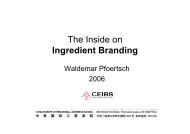Case Studies
Case Studies
Case Studies
You also want an ePaper? Increase the reach of your titles
YUMPU automatically turns print PDFs into web optimized ePapers that Google loves.
which marketed multiple brands and controlled nearly 40 percent of the market before P&G's<br />
entry. P&G's success with Joy was due to its ability to develop a product formula that was<br />
specifically targeted at the unmet needs of Japanese consumers, to the design of a packaging<br />
format that appealed to retailers, and to the development of a compelling advertising<br />
campaign.<br />
In researching the market in the early 1990s, P&G discovered an odd habit; Japanese<br />
homemakers, one after another, squirted out excessive amounts of detergent onto dirty dishes,<br />
a clear sign of dissatisfaction with existing products. On further inspection, P&G found that<br />
this behavior resulted from the changing eating habits of Japanese consumers. The Japanese<br />
are consuming more fried food, and existing dish soaps did not effectively remove grease.<br />
Armed with this knowledge, P&G researchers in Japan went to work to create a highly<br />
concentrated soap formula based on a new technology developed by the company's scientists<br />
in Europe that was highly effective in removing grease. The company also designed a novel<br />
package for the product. The packaging of existing products had a clear weakness; the longnecked<br />
bottles wasted space on supermarket shelves. P&G's dish soap containers were<br />
compact cylinders that took less space in stores, warehouses, and delivery trucks. This<br />
improved the efficiency of distribution and allowed supermarkets to use their shelf space<br />
more effectively, which made them receptive to stocking Joy. P&G also devoted considerable<br />
attention to developing an advertising campaign.<br />
<strong>Case</strong> Discussion Question<br />
1. How would you characterize P&G’s product development and marketing strategy<br />
toward Japan in the 1979s and 1980s. What were the advantages of this strategy<br />
What were the drawbacks<br />
2. How would you characterize the strategy since the early 1990s What are the<br />
advantages of this strategy What were the drawbacks<br />
3. Which strategy has been more successful Why<br />
4. What changes do you think P&G has had to make in its organization and company<br />
culture to implement this strategic shift<br />
5. What does P&G’s experience teach us about the argument that consumer tastes<br />
and preferences across nations are covering and global markets are becoming more<br />
homogeneous







